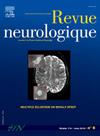ALS呼吸管理的进展和研究重点:历史观点和新技术。
IF 2.3
4区 医学
Q2 CLINICAL NEUROLOGY
引用次数: 0
摘要
自19世纪肌萎缩性侧索硬化症(ALS)的最早描述以来,呼吸受累已被确定为其主要特征。自这些最初的报告以来,已经进行了大量的研究,以阐明与呼吸损害相关的病理生理学和进展率,并制定了有效的管理策略。临床试验通常将呼吸测量作为研究终点,无创通气现在在家庭环境中广泛使用,咳嗽辅助技术被广泛使用,先进的神经生理学技术和可穿戴技术已被纳入呼吸监测方案,姑息治疗指南已被开发出来,以有效地管理呼吸窘迫。尽管这些干预措施得到了广泛实施,但流行病学研究并不一致,一些研究表明,ALS患者的生存率并没有随着这些措施的引入而显著提高。膈肌起搏试验的结果令人失望,先进的神经生理学技术没有常规应用,脊髓和脑干成像不常见,在进行气管切开术时存在显著的地理差异。全球范围内的COVID大流行推动了ALS的远程监测、联网设备、视频咨询和及时疫苗接种;这些教训在大流行之后很长一段时间都是无价的。ALS的呼吸监测和管理是ALS护理的一个迅速发展的方面,具有相当大的生活质量效益。本文章由计算机程序翻译,如有差异,请以英文原文为准。
Advances and research priorities in the respiratory management of ALS: Historical perspectives and new technologies
Respiratory involvement has been identified as a cardinal feature of amyotrophic lateral sclerosis (ALS) since its earliest descriptions in the 19th century. Since these initial reports, considerable research has been undertaken to clarify the pathophysiology and progression rates associated with respiratory compromise and effective management strategies have been developed. Clinical trials routinely incorporate respiratory measures as study end points, non-invasive ventilation is now widely used in the home setting, cough-assist techniques are commonly used, advanced neurophysiology techniques and wearable technologies have been integrated into respiratory monitoring protocols, and palliative guidelines have been developed to effectively manage respiratory distress. Despite the widespread implementation of these interventions, epidemiology studies are inconsistent and some studies suggest that survival in ALS has not improved significantly with the introduction of these measures. The outcomes of diaphragmatic pacing trials have been disappointing, advanced neurophysiology techniques are not routinely utilised, spinal and brainstem imaging are not commonly undertaken and significant geographical differences exist in proceeding to tracheostomy. The worldwide COVID pandemic has given impetus for remote monitoring, connected devices, video-consultations, and timely vaccinations in ALS; lessons that are invaluable long after the pandemic. Respiratory monitoring and management in ALS is a swiftly evolving facet of ALS care with considerable quality of life benefits.
求助全文
通过发布文献求助,成功后即可免费获取论文全文。
去求助
来源期刊

Revue neurologique
医学-临床神经学
CiteScore
4.80
自引率
0.00%
发文量
598
审稿时长
55 days
期刊介绍:
The first issue of the Revue Neurologique, featuring an original article by Jean-Martin Charcot, was published on February 28th, 1893. Six years later, the French Society of Neurology (SFN) adopted this journal as its official publication in the year of its foundation, 1899.
The Revue Neurologique was published throughout the 20th century without interruption and is indexed in all international databases (including Current Contents, Pubmed, Scopus). Ten annual issues provide original peer-reviewed clinical and research articles, and review articles giving up-to-date insights in all areas of neurology. The Revue Neurologique also publishes guidelines and recommendations.
The Revue Neurologique publishes original articles, brief reports, general reviews, editorials, and letters to the editor as well as correspondence concerning articles previously published in the journal in the correspondence column.
 求助内容:
求助内容: 应助结果提醒方式:
应助结果提醒方式:


